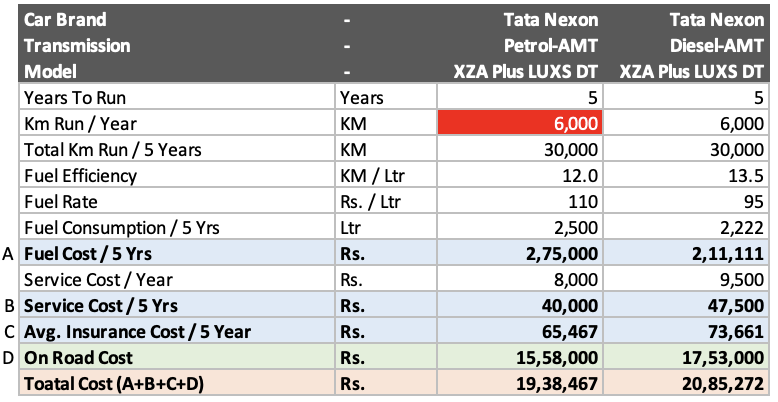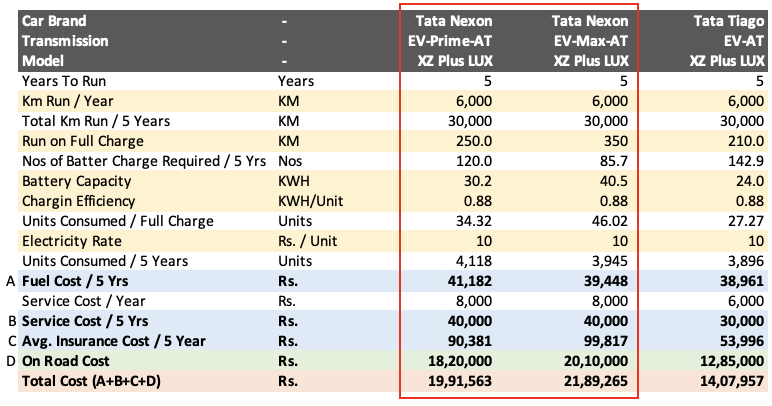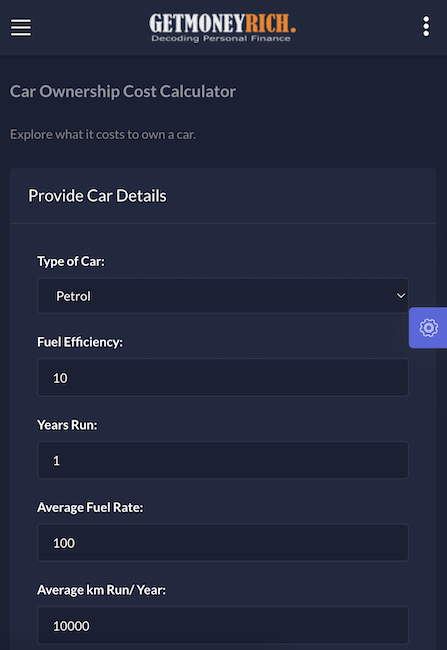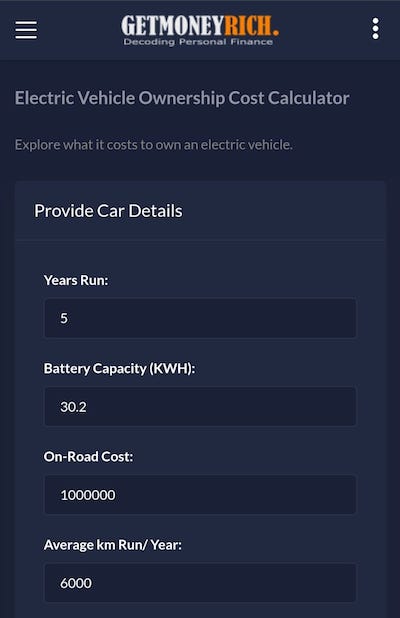My father has a VW Polo petrol since 2016. Being a retired man, he does not drive much. But he wants to get rid of the hassle of going to fuel stations to get the car refueled. Moreover, he also wants to contribute (carbon Footprint) by switching to an EV. Hence, he proposed to change the car from Petrol to an EV. Being an Ex Tata, the Tata Nexon EV Max (2023) is his pick. So I thought to check the economics of driving electric vehicles (EVs).
People who are looking to change cars now are definitely considering the option of an Electric Vehicle (EV). This is more relevant to those buyers whose preference is a hatchback or a compact SUV. Currently, there are budget EVs on offer by Tata and Mahindra. These cars are available at an on-road price ranging between Rs.12 to Rs.20 Lakhs.
Comparing the cost of purchase of EVs with their Petrol and Diesel Automatic variants, petrol and diesel cars are 30% cheaper. However, the cost of charging and maintenance of EVs is very low.
So, on one side we have EVs whose one-time purchase cost is about 30% higher. Then there are petrol and diesel cars whose cost of refueling is about 4 times higher than that of EVs.
So the question is, which is more cost-effective, EVs or traditional cars? Let’s answer it.
Requirement
There are two use cases of cars for us. The first is for office commuting and the second for long trips. I’m not considering the use case of cars as a taxi.
- Office Commute: The car is mainly used for office commuting within the city. To travel longer distances, there is another car available. For such a use case, I’m assuming a budget EV with a range of 200 KM will be sufficient.
- Long Trips: Here the car is also used for longer trips, say on weekends. For this type of use, I’m assuming a budget EV with a range of 350 KM will be necessary.
Our next step will be to select a budget EV that matches the above two requirements.
Car Selection
Primarily, we’ll consider only the budget EVs available in the market. We’ll pick only that EV whose Petrol/Diesel variants are also available. This way, we can make an apple-to-apple comparison.
- Office Commute: For this type of commute, we can pick Tata Nexon EV Prime. This car can offer a range of about 250 km on a full charge. If the person wants to avail a more economical car, then the Tata Tiago EV is a more budget-friendly car with a range of 210 Km.
- Long Trips: For this type of commute, we will pick the Tata Nexon EV Max. Its range on full charge is 350 km. Here I’m assuming that a long trip is about 150 km on one side.
These EVs will be compared with two similar cars running on traditional fuels, Tata Nexon Petrol AMT and Diesel AMT.
Please note that EVs inherently have an automatic transmission. Hence to have an even match of cars from the Petrol and Diesel segments, I’ve referred only to the automatic variants (AMT) for comparison purposes.
Cost of Driving A Car
To calculate the cost of driving a car, we’ll use four parameters:
- On-road cost of the brand new car (purchase cost).
- Refueling cost the car (for 5 years).
- Servicing cost of the car (for 5 years).
- Comprehensive insurance cost (for 5 years).
Using these costs as our basis, we will calculate the cost of owning the car for a five-year period. In these five years, only the cost of purchasing a new car is a one-time expense. All the other three costs are of recurring in nature.
I’ve assumed only a five-year period as ownership because I’m assuming that the battery health will be best during this period only. After five years, the charging speed and charge retention quality will substantially go down. Hence, the end of the fifth year is the time to change the car.
Petrol and Diesel Car [With Online Calculator]

In this section, we’ll calculate the cost of driving a petrol and a diesel car. In this calculation, I’ve assumed the following:
- Car Make and Model: Tata Nexon
- Years for this the car is used for commuting: 5 Years
- Kilometer run each year: 6,000 KM
- Fuel Efficiency (Km/Ltr): 12 (petrol) and 13.5 (diesel)
- Fuel Rate (Rs./Ltr): 110 (petrol) and 95 (diesel)
- Service cost (Rs./year): 8000 (petrol) and 9500 (diesel)
- Insurance (IDV): Average for 4 years 55% of the on-road cost
- Insurance (Premium): 1.91% of IDV
With these as our assumption, the total cost of driving petrol and diesel cars is as below:
| . | Car Brand | – | Tata Nexon | Tata Nexon |
| . | Transmission | – | Petrol-AMT | Diesel-AMT |
| . | Model | – | XZA Plus LUXS DT | XZA Plus LUXS DT |
| A | Fuel Cost / 5 Yrs | Rs. | 2,75,000 | 2,11,111 |
| B | Service Cost / 5 Yrs | Rs. | 40,000 | 47,500 |
| C | Avg. Insurance Cost / 5 Year | Rs. | 65,467 | 73,661 |
| D | On Road Cost | Rs. | 15,58,000 | 17,53,000 |
| . | Toatal Cost (A+B+C+D) | Rs. | 19,38,467 | 20,85,272 |
- Tata Nexon Petrol (AMT): The on-road cost of this car is about 15,58,000. Taking into consideration the kilometers run, fuel consumption, annual maintenance, and insurance cost, the total cost to run this vehicle for five (5) years, is about Rs.19,38,467.
- Tata Nexon Diesel (AMT): The on-road cost of this car is about 17,53,000. It is 12.5% more expensive than the Petrol variant. Though the total cost of refueling the diesel car variant, in a 5-year period, is 23% less than petrol. But the car is also expensive in terms of servicing cost and insurance. Hence, the total cost to run this vehicle for five (5) years, is about Rs.20,85,272 (7.5% higher than its petrol variant).
EV – Electric Vehicle [With Online Calculator]

In this section, we’ll calculate the cost of driving an electric vehicle (EV). In this calculation, I’ve assumed the following:
- Car Make and Model: Tata Nexon EV (Prime & Max)
- Years for this the car is used for commuting: 5 Years
- Car’s ability to run on full charge (KM): 250 (Prime), 350 (Max)
- Battery Capacity (KWH): 30.2 (Prime), 40.5 (Max)
- Charging Efficiency of Battery: 88%
- Electricity Rate (Rs./unit): 10
- Service cost (Rs./year): 8000
- Insurance (IDV): Average for 4 years 55% of the on-road cost
- Insurance (Premium): 1.91% of IDV
With these as our assumption, the total cost of driving an electric vehicle (EV) looks like below:
| . | Car Brand | – | Tata Nexon | Tata Nexon | Tata Tiago |
| Transmission | – | EV-Prime-AT | EV-Max-AT | EV-AT | |
| Model | – | XZ Plus LUX | XZ Plus LUX | XZ Plus LUX | |
| A | Fuel Cost / 5 Yrs (X) | Rs. | 41,182 | 39,448 | 38,961 |
| B | Service Cost / 5 Yrs (Y) | Rs. | 40,000 | 40,000 | 30,000 |
| C | Avg. Insurance Cost / 5 Year | Rs. | 90,381 | 99,817 | 53,996 |
| D | On Road Cost (Z) | Rs. | 18,20,000 | 20,10,000 | 12,85,000 |
| . | Total Cost (A+B+C+D) | Rs. | 19,91,563 | 21,89,265 | 14,07,957 |
Conclusion #1 (Short Trips)
Let’s look at the economics of driving electric vehicles (EVs). For that, we’ll compare the cost of running EVs over petrol and diesel cars.
- Tata Nexon EV (Price): The on-road cost of this car is about 18,20,000 (16.8% higher than the Petrol variant). However, the total cost of charging the batteries, in a 5-year period, is 85% less than the cost of refueling its petrol variant (Rs.41,182 vs. Rs.2,75,000). The car is also cheap in terms of servicing cost and insurance. Hence, the total cost to run this vehicle for five (5) years, is about Rs.19,91,563 (only 2.7% higher than petrol).
- Tata Nexon Diesel (AMT): The on-road cost of this car is about 20,10,000 (29% higher than the Petrol variant). However, the total cost of charging the batteries, in a 5-year period, is 85.6% less than the cost of refueling its petrol variant (Rs.39,448 vs. Rs.2,75,000). The car is also cheap to service and get insured. But still, the total cost to run this vehicle for five (5) years, is about Rs.21,89,265 (13% higher than petrol).
So we can conclude that if the average run of the car is about 6000 Kilometers in a year, a petrol car is still more cost-effective. Though the Nexon EV (Prime) is proving only 2.7% costlier than Petrol.
So for people who want to use their cars only for office commuting, where the average commute per year is close to 6000 km a day, a Tata Nexon Petrol is best. But if you are okay with spending that 2.7 % extra in a 5-year period, Tata Nexon EV (Prime) is also a suitable option.
A better car for office commuting is Tata Tiago EV. The cost of running this car is a 5-year period, is 27.4% less than even Tata Nexon Petrol (AMT). What makes this car moe cost effective for everyday office commuting is its lower on-road cost. Though it must be kept in mind that Tata Tiago will only go about 210 Km on a full battery. Hence, it is only suitable for shorter rides withing the city.
Conclusion #2 (Long Trips)
For people who cannot compromise on long hauls with their Electric Cars (EVs), a more suitable option is the Tata Nexon EV (Max). Though the total cost of purchasing, running, maintaining, and insuring this car is higher (10% more) than the EV-Prime, still it is a better buy. The EV-Prime has only a 250 Km range compared to the 350 Km range of the EV-Max. For long trips on expressway types of roads, the range of 350 Km is more apt.
Conclusion #3 (Higher Kilometers Per Year)
What happens if a person covers more than 6000 kilometers in a year? Will the situation remain the same? Petrol cars will still dominate the EVs and Diesel cars?

For people who use their cars for more than 7,000 km in a year, the Tata Nexon EV-Prime becomes a more economical car than its Petrol variant. Above 13,000 Km in a year, the Tata Nexon EV-Max has become the second most affordable car.
But if someone is not bent on using their EV car for long drives, the most economical car in this case becomes the Tata Tiago EV.
Have a happy investing
Suggested Reading:






